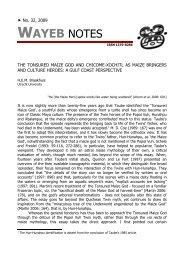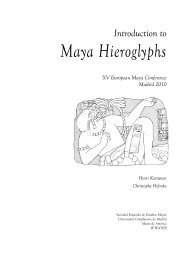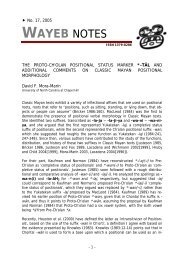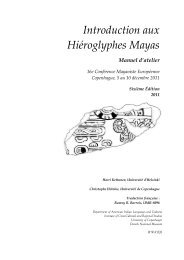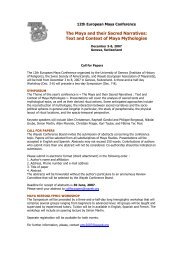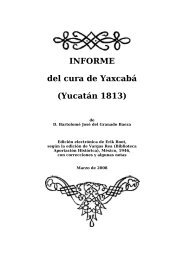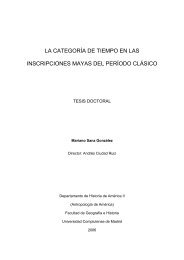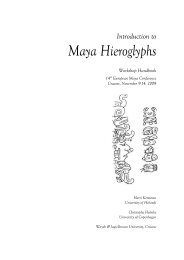Introduction to Maya Hieroglyphs - Wayeb
Introduction to Maya Hieroglyphs - Wayeb
Introduction to Maya Hieroglyphs - Wayeb
Create successful ePaper yourself
Turn your PDF publications into a flip-book with our unique Google optimized e-Paper software.
Kettunen & Helmke 2011<br />
Appendices<br />
Table of different arrangements with examples:<br />
Arrangement: Outcome: Example: Transcription: Translation:<br />
CAC / Ca-Ca CaC la-ka lak plate<br />
CAC / Ca-Ci CaaC ba-ki baak captive<br />
CAC / Ca-Cu Ca’(a)C ba-tz’u ba’tz’ howler monkey<br />
CEC / Ce-Ce CeC te-me tem throne<br />
CEC / Ce-Ci CeeC? ke-ji keej deer<br />
CEC / Ce-Ca Ce’(e)C ne-na ne’[h]n mirror<br />
CIC / Ci-Ci CiC wi-tzi witz mountain<br />
CIC / Ci-Cu Ci’(i)C chi-ku chi’k coati<br />
CIC / Ci-Ca CiiC yi-tz’i-na yi[h]tz’iin younger brother<br />
COC / Co-Co CoC yo-po yop leaf<br />
COC / Co-Ci CooC xo-ki xook shark<br />
COC / Co-Ca Co’(o)C o-la o’[h]l heart<br />
CUC / Cu-Cu CuC k’u-hu k’uh god<br />
CUC / Cu-Ci CuuC mu-chi muuch <strong>to</strong>ad<br />
CUC / Cu-Ca Cu’(u)C bu-la bu’ul bean<br />
Table XVIII: Examples based on harmony rules according <strong>to</strong> Lacadena and Wichmann (2004)<br />
One of the (rare) disharmonic patterns in the script is that of CEC / Ce-Cu which is not included in Table XVIII<br />
above. Lacadena and Wichmann (2004) proposed that this pattern most likely does not belong <strong>to</strong> the sphere of<br />
harmony rules but is rather another example of underspelling. 64 Thus there are two possible outcomes for the<br />
following arrangements:<br />
CEC / Ce-Cu Ce’(e)C che-bu che’[eh]b? / chebu[l]? quill, brush<br />
” ” te-mu te’m? / temu[l]? seat, bench, throne<br />
Examples of exceptions <strong>to</strong> the “normal disharmonic spelling rules” (=underspelled sounds):<br />
Arrangement: Outcome: Example: Transcription: Translation:<br />
CAC / Ca-Ce ? BAK-ke ba[a]ke[l] child<br />
VCAC / Ca-Ce ? AJAW-le ajawle[l] lordship, kingdom<br />
CAC / Ca-Co ? ch’a-ho ch’aho[’m] man<br />
CEC / Ce-Cu ? e-bu e[h]bu[l] stair<br />
CEC / Ce-Co ? *not attested*<br />
CIC / Ci-Ce ? *not attested*<br />
CIC / Ci-Co ? ti-ho tiho[’] (a <strong>to</strong>ponym)<br />
COC / Co-Ce ? o-ke o[o]ke[l] foot<br />
COC / Co-Cu ? *not attested*<br />
CUC / Cu-Ce ? u-ne? une[n]? baby<br />
CUC / Cu-Co ? *not attested*<br />
CUC / Cu-Ca ? tu-pa tupa[j]? earspool<br />
Table XIX: Examples of underspelled words<br />
The following sounds are frequently underspelled <strong>to</strong>wards the end of words and in the case of consonant clusters<br />
(-C# and -CC-): /l/, /m/, /n/, /h/, /j/, and /’/. Examples of words with underspelled sounds at the end of the word<br />
include: bi > bi[h] (“road”), chi > chi[j] (“deer”), sa-ja > saja[l] (title), tz’u-nu > tz’unu[n] (“hummingbird”), a-u-ku ><br />
a[j]uku[l] (proper name), and YAX-a > Yaxa[’] (“Yaxha’” [<strong>to</strong>ponym]). Examples of words with underspelled<br />
sounds in –CC- surroundings (consonant clusters/ double consonants) include: ja-wa-TE’ > jawa[n]te’ (“tripod<br />
64<br />
Moreover, Wichmann reasons that “Possibly a scribe was playing with the conventions and introduced e-u as a rule, but we have <strong>to</strong> consider the<br />
possibility that there is a suffix -u[l] in play. It is <strong>to</strong>o much <strong>to</strong> sacrifice the simplicity of the system when there’s so few examples and when they<br />
could involve underspelled suffixes.” (personal communication, 2002).<br />
64/154



